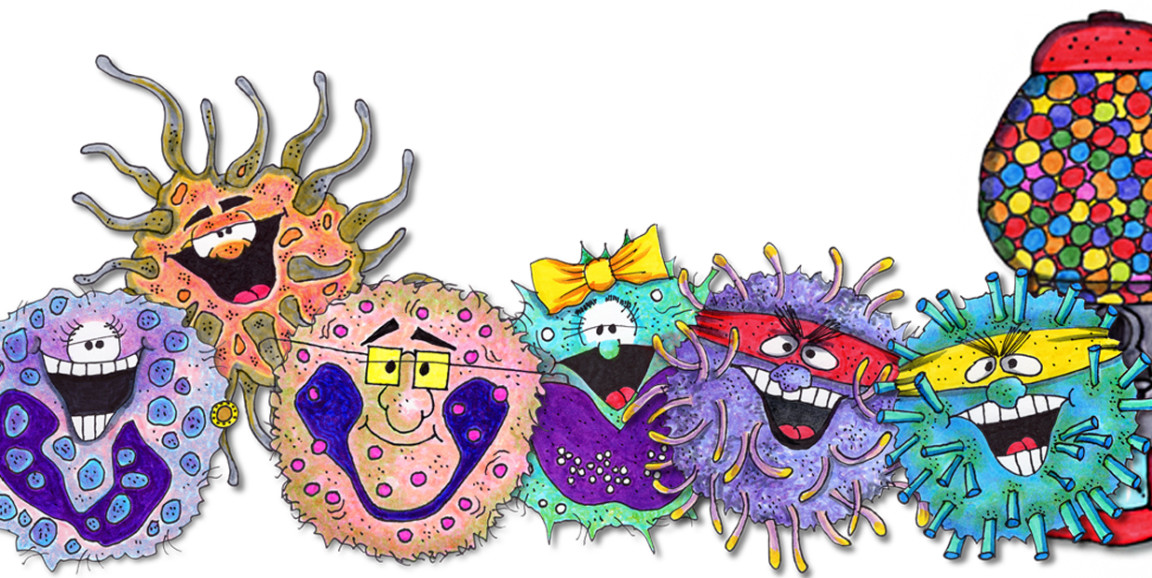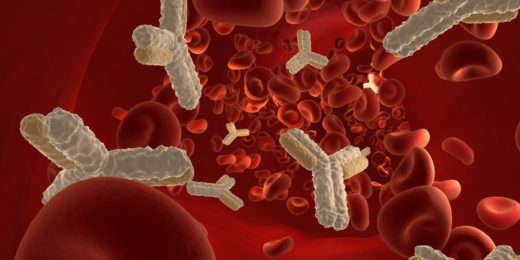In 2015, when Rob Henslin stopped by Stanford Hospital to visit his former oncology nurses, he discovered they had a project in mind for him. They wanted him to write a book to help children understand stem cell transplants.
"It was slightly intimidating," said Henslin, chuckling, when I spoke to him recently. "They were super fired up." But he recognized the value of what the nurses suggested. He'd wished for a similar resource when facing his own stem cell transplant, which he received at Stanford Hospital in 2009.
Henslin's background convinced his nurses he'd be up to the task of writing the sort of book they had in mind. He's a graphic designer, illustrator and cancer survivor who has written two memoirs about his experiences with leukemia, which was first diagnosed in 1989, when he was in his 20s, and recurred in 2008.

The nurses were right: Henslin's new book, called Neutrophil's Guide to Stem Cell Transplants for Kids, came out recently and is beginning to be adopted by children's hospitals around the country.
Stem cell transplants, also known as bone marrow transplants, can cure certain blood cancers and genetic diseases.
They are complex procedures in which a patient's diseased blood-forming stem cells are replaced by healthy cells, usually from a donor, giving the patient a brand-new immune system.
Children facing transplant need age-appropriate explanations of the biology of the treatment, but even more, they need resources that account for what it feels like to be a child living with a serious illness.
Henslin's nurses have lots of experience helping adults navigate the process. But not long before his chat with them, they had attended a professional conference where they'd realized such resources for kids were lacking, they told him.
"I wanted [the book] to be a practical help, and also something that could come alongside of these kids who are already sick -- like I was sick before my transplant -- with a voice of hope, a sense of compassion and a sense of humor," said Henslin.
"I hope the book can make the journey more palatable and understandable, both for adult caregivers and the child they're caring for."
Helping kids feel brave
On the first page of Henslin's story, Neutrophil, a cartoon immune cell character who wears Aloha shirts, striped shorts and red sneakers, tells the reader about his superpower. Neutrophil can detect bravery, even in people who don't know they are brave. From the book:
You know what? I'm sensing waves of bravery coming off you right now! Wait a minute ... okay ... yes! My detector is going crazy ...
You know something inside your body isn't working right. You've already had to face some very scary and difficult things. You might have cried or been angry because you haven't felt well. And you might be scared about what happens next.
In spite of all that, YOU ARE BRAVE.
Neutrophil takes readers, step by step, through the science of stem cell transplant, starting with simple explanations of what's in blood and the immune system.
Several chapters focus on practical details of transplant, such as who is on patients' medical teams, and what tests are performed before the procedure. The book also describes what to expect from the long hospitalization needed to protect patients while their new immune systems are getting safely established in their bodies.
Henslin worked with a large team of reviewers, including experts in pediatric stem cell transplant and a group of middle-school-aged kids, to make sure all the material is accurate and presented in a way that connects with the intended audience. Each chapter includes a summary section for parents, intended to help them capture essential content and review the material with their children.

Finally, the book discusses what happens after transplant, covering going home from the hospital and how kids who have received a stem cell transplant can care for their emotions as well as their bodies as they recover. Henslin also infused the Life After Your Transplant chapter with some wisdom from his own journey with blood cancer.
"Neutrophil says, 'I want to give you some advice,' and there are three things I have him say that are very much borne out of my own experience," Henslin said. He encourages kids to celebrate the anniversary of the day they received their new stem cells as a second birthday; to listen to their bodies, especially if they begin to feel run down; and to focus their energy as much as possible on what lies ahead.
Henslin said writing has helped him focus his own life on what's ahead. During his stem cell transplant, when he was so exhausted it took 20 minutes to get a glass of water from the kitchen, he could still keep a journal. That grew into his self-published memoirs, and it also shaped his habit of looking for ways to help others in similar situations. He hopes his new book will inspire kids and families to get to the other side of their transplant with courage.
"Your life following transplant is like a new life," Henslin said when we talked. As Neutrophil puts it in the book, "Take good care of yourself, keep your eyes looking forward, and live a long, strong and happy life."
Images from Neutrophil's Guide to Stem Cell Transplants for Kids courtesy of Rob Henslin.






